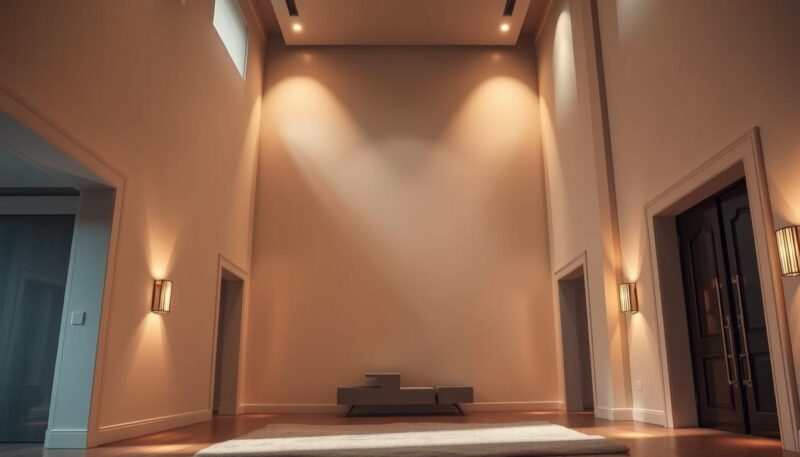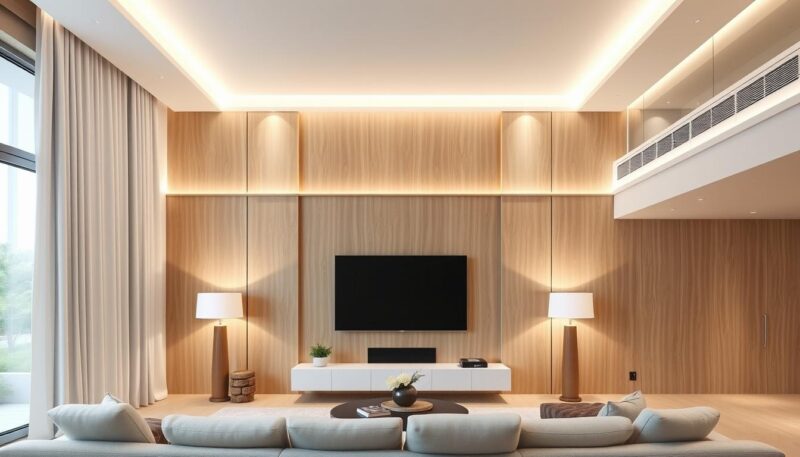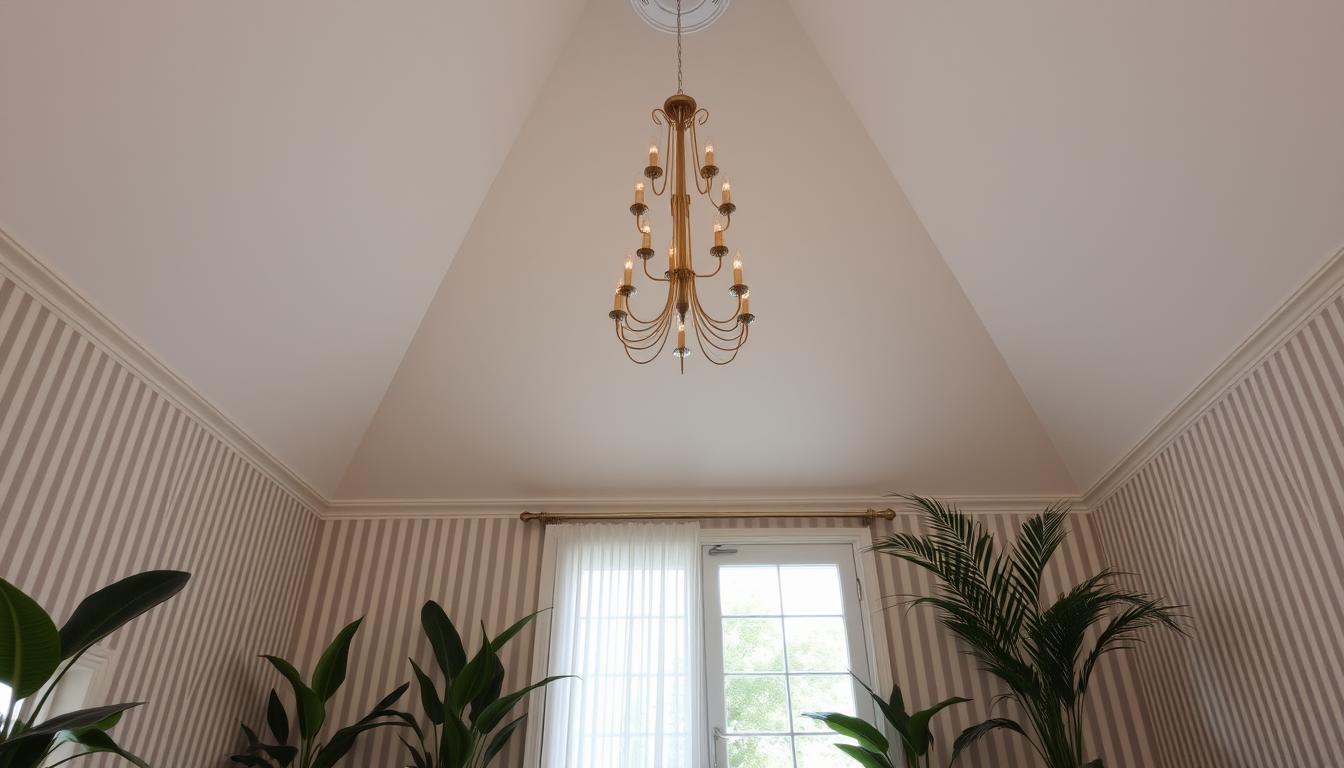Having a low ceiling can present a unique challenge when it comes to interior design, but with the right strategies, you can create the illusion of a taller, more spacious environment. Interior design experts have developed a range of simple yet effective techniques to visually enhance the perceived height of any room. From carefully selecting your furnishings and decor to incorporating strategic lighting and architectural elements, there are numerous ways to make a ceiling look taller without major structural changes.
In this article, we’ll explore a variety of design tricks and tips that can help you transform a space with a lower ceiling into a bright, airy, and visually elevated oasis. Whether you’re working with a cozy apartment or a sprawling home, these simple design solutions can make a significant difference in how you experience the height and overall ambiance of a room.
Key Takeaways
- Opt for low-profile furniture and horizontal pieces to create the illusion of increased ceiling height
- Incorporate strategic lighting techniques, such as flush-mounted fixtures and uplighting, to enhance the perception of vertical space
- Use vertical stripes, patterns, and artwork arrangements to draw the eye upward and make the ceiling appear taller
- Leverage high-gloss finishes and diagonal lines to create an optical illusion of increased height
- Minimize clutter and choose a clean, minimalist aesthetic to maximize the sense of open space
Choose Low-Profile Furniture to Enhance Visual Height
When working with a room that has low ceilings, one of the key strategies is to opt for furniture that sits close to the floor. Selecting low-profile furniture can create the illusion of increased vertical space, making the room feel more open and airy. Avoid tall, bulky pieces that visually divide the space and draw the eye downward.
Opt for Low and Horizontal Pieces
Look for sofas, chairs, and tables with a horizontal design and low proportions. This allows more of the wall to be visible, further enhancing the sense of maximizing visual height in the room. Pairing these low-profile furniture pieces with simple window treatments can help open up the room and create a seamless, uninterrupted flow from floor to ceiling.
Keep Window Treatments Simple
Avoid heavy, layered window treatments that can visually cut the space in half. Instead, opt for simple window treatments that allow as much natural light to filter in as possible. This helps to create the illusion of increased proportions and scale within the room, making the ceilings feel taller and the overall space more open and inviting.
Clever Lighting Techniques to Maximize Vertical Space
The placement and type of lighting can have a significant impact on the perceived height of a room. To create the illusion of a taller ceiling, focus on strategic lighting placement and the use of flush-mounted fixtures and uplighting techniques.
Keep Lighting Fixtures Flush Against the Ceiling
Opt for lighting fixtures that sit close to the ceiling, such as recessed lights or low-profile ceiling-mounted units. This creates vertical visual cues and avoids drawing the eye downward, which can make the room feel smaller and more confined.
Utilize Uplighting for a Floating Ceiling Effect
Incorporate uplighting techniques, such as wall sconces or cove lighting, to enhance the sense of height. Uplighting directs light upwards, creating the illusion of a floating ceiling and drawing the eye upwards. This layered lighting design can dramatically maximize vertical space.

“Proper lighting can make a room feel significantly taller and more open. By keeping fixtures flush against the ceiling and utilizing uplighting, you can create a sense of visual drama and expansiveness.”
How to Make a Ceiling Look Taller? Using Vertical Lines and Patterns
If you’re looking to enhance the perceived height of your ceiling, incorporating vertical elements into your design can be a game-changer. From strategically placed vertical stripes and patterns to eye-catching vertical displays, these simple tricks can draw the eye upward and create the illusion of a taller, more expansive space.
Incorporate Vertical Stripes and Patterns
Vertical lines and patterns have a remarkable ability to guide the eye upward, making your ceiling appear higher than it actually is. Consider incorporating vertical stripes on your walls or exploring textured patterns that emphasize height, such as chevrons or herringbone. These visual cues create a sense of vertical flow, drawing the attention towards the ceiling and enhancing the overall sense of scale in the room.
Draw the Eye Upward with Vertical Displays
Strategically placing vertical elements, such as tall mirrors, floor-to-ceiling bookshelves, or statement light fixtures, can effectively draw the eye upward and create the impression of a taller ceiling. These vertical displays act as focal points, guiding the viewer’s gaze towards the ceiling and creating a heightened sense of visual interest. Experiment with different arrangements and scales to find the right balance that elevates the overall ambiance of the space.
By incorporating vertical lines, patterns, and displays, you can effortlessly make your ceiling appear taller and create a more visually striking and cohesive interior design. These simple yet impactful techniques can transform the perceived height of your space, evoking a greater sense of openness and grandeur.
Enhance Architectural Features to Heighten the Room
Leveraging architectural elements can be an effective way to make a ceiling appear taller. One clever trick is to opt for high-gloss or mirrored ceilings, which can create an illusion of endlessness and depth. This reflective surface bounces light around the room, giving the impression of a grander, more expansive space.
Another technique to heighten the room is to introduce diagonal lines. Incorporating these dynamic design elements, such as through stair railings or wall features, can draw the eye upward and lift the overall perception of the space. This strategic placement of diagonal lines creates a sense of visual depth, enhancing the spatial perception and making the ceiling seem higher.
Consider High-Gloss Ceilings for an Illusion of Endlessness
High-gloss ceilings, or even mirrored surfaces, are a fantastic way to create the illusion of a taller, more expansive room. The reflective quality of these architectural features bounce light around, giving the impression of a never-ending space. This visually amplifies the sense of height and depth, making the room feel more open and airy.
Introduce Diagonal Lines to Lift the Space
Incorporating diagonal lines, such as through stair railings or feature walls, can draw the eye upward and heighten the perception of the room. These dynamic design elements create a sense of visual depth, guiding the gaze towards the ceiling and making the space feel more elevated. By strategically placing diagonal lines, you can enhance the spatial awareness and make the ceiling appear taller.
| Architectural Feature | Impact on Ceiling Height |
|---|---|
| High-Gloss Ceilings | Creates an illusion of endlessness and depth |
| Diagonal Lines | Draws the eye upward, enhancing spatial perception |
Optimize Wall Treatments for an Elevated Ambiance
The way you treat the walls in a room can significantly impact the perceived ceiling height. Incorporating vertical paneling or running wall treatments vertically can create the illusion of increased height. These vertical elements draw the eye upward, reinforcing the sense of scale and proportion in the space.
Run Paneling Vertically to Accentuate Height
Vertical paneling is a simple yet effective technique to accentuate height and create a cohesive, visually appealing design. The vertical lines draw the eye upward, making the ceiling appear taller. This approach works especially well in rooms with standard 8-foot ceilings, which are common in many homes.
- Use light, bright colors for the paneling to enhance the sense of openness and spaciousness.
- Opt for a monochromatic color scheme to elongate the walls and ceilings further.
- Avoid high-gloss finishes on the ceiling, as they can draw attention to imperfections, especially in older homes.
By incorporating these vertical design elements, you can create a cohesive and visually striking environment that accentuates the height of the room.

Embrace Minimalism and Strategic Decor Placement
Adopting a minimalist approach and strategically placing your decor can work wonders in making a ceiling appear taller. By exposing structural elements, such as beams or ductwork, you can add visual depth and draw the eye upward, creating an impression of greater height. Maintaining an uncluttered and open layout, free of excess furnishings and decor, can further enhance the sense of spaciousness and height in the room.
Expose Structural Elements for Added Visual Depth
Highlighting the existing architectural features of your space can significantly contribute to the illusion of a taller ceiling. Consider exposing structural elements like beams or ductwork, which can draw the eye upward and create a sense of depth and dimension. This strategic placement of decor can help maximize the visual perception of height in the room.
Maintain an Uncluttered and Open Layout
A minimalist approach to your decor can also play a vital role in making a ceiling feel taller. By keeping the layout uncluttered and maintaining an open, airy feel, you can avoid the visual obstruction that excess furnishings and decor can create. This uncluttered aesthetic allows the eye to flow freely through the space, enhancing the overall sense of spaciousness and height.
“Quality, timeless furniture pieces contribute to the longevity and style of a minimalist home, focusing on durability and aesthetic charm.”
Embracing minimalism and strategically placing your decor can be powerful tools in creating the illusion of a taller ceiling. By exposing structural elements and maintaining an uncluttered, open layout, you can maximize the visual depth and perception of height in your space, transforming it into a more inviting and visually expansive environment.
Conclusion
By incorporating a variety of design techniques, including the strategic use of furniture, lighting, architectural features, wall treatments, and minimalist decor, it is possible to create the illusion of a taller ceiling in any room. These simple yet effective tricks can transform a space, making it feel more open, airy, and visually appealing.
From choosing low-profile furniture to optimizing lighting and incorporating vertical lines, the strategies outlined in this article can help you maximize the perceived height of your room. Additionally, embracing architectural elements like high-gloss ceilings and diagonal lines, as well as utilizing minimal and strategic decor placement, can further enhance the sense of vertical space.
Ultimately, with a few carefully considered adjustments, you can overcome the challenges of a low ceiling and create a visually captivating and spacious environment that suits your style and needs. By focusing on these design techniques, you can unlock the full potential of your room and enjoy a more elevated and inviting atmosphere.
FAQ
How can I make my ceiling look taller?
To create the illusion of a taller ceiling, interior design experts recommend using low-profile furniture, incorporating vertical lines and patterns, leveraging strategic lighting techniques, and enhancing architectural features. By carefully selecting colors, furnishings, and decor placements, you can visually expand the perceived height of any room.
What type of furniture should I choose to make the ceiling appear taller?
Selecting low-slung furniture that sits close to the floor can help create the illusion of a taller ceiling. Opt for sofas, chairs, and tables with a low profile, and keep window treatments simple to avoid visually dividing the space. This strategy allows more of the wall to be visible, making the room feel more open and spacious.
How can lighting affect the perceived height of a room?
The placement and type of lighting can significantly impact the perceived height of a room. Use flush-mounted fixtures that sit close to the ceiling to avoid drawing the eye downward. Incorporate uplighting, such as sconces or cove lighting, to create the illusion of a floating ceiling. These techniques draw the eye upward, making the space feel more expansive.
What design elements can create the illusion of a taller ceiling?
Incorporating vertical elements, such as stripes, patterns, and vertically-oriented displays, can effectively make a ceiling appear taller. Vertical lines guide the eye upward, and strategically placed vertical features, like tall mirrors or artwork, draw attention towards the ceiling. These visual cues create the perception of increased height in the space.
How can architectural features enhance the perceived ceiling height?
Leveraging architectural elements can be an effective way to make a ceiling appear taller. Opt for high-gloss or mirrored ceilings, which can create an illusion of endlessness and depth. Incorporating diagonal lines, such as through stair railings or wall features, can also draw the eye upward and lift the overall perception of the space.
What wall treatments can help make a ceiling look taller?
The way you treat the walls in a room can significantly impact the perceived ceiling height. Incorporating vertical paneling or running wall treatments vertically can create the illusion of increased height. These vertical elements draw the eye upward, reinforcing the sense of scale and proportion in the space.
How can minimalism and strategic decor placement contribute to a taller-looking ceiling?
Adopting a minimalist approach and strategically placing decor can also help make a ceiling appear taller. Expose structural elements, such as beams or ductwork, to add visual depth and draw the eye upward. Maintaining an uncluttered and open layout, free of excess furnishings and decor, can further enhance the sense of spaciousness and height in the room.
Source Links
- https://judithtaylordesigns.com/make-ceiling-look-higher/
- https://www.homesandgardens.com/news/tricks-to-make-living-room-ceilings-look-higher
- https://www.texturiousdesigns.com/blog/10-ways-to-make-your-ceilings-look-higher
- https://www.kylieminteriors.ca/8-ideas-to-make-your-low-ceiling-look-higher/
- https://www.metrie.com/the-finished-space/en-blog-how-to-make-low-ceilings-look-higher
- https://www.houzz.com/magazine/11-tricks-to-make-a-ceiling-look-higher-stsetivw-vs~17752479
- https://www.dreammaker-remodel.com/schaumburg/2023/06/12/clever-ways-to-make-your-ceilings-look-higher/
- https://www.houzz.com/magazine/embrace-your-low-ceiling-with-one-of-these-clever-design-tricks-stsetivw-vs~92520057
- https://erinkestenbaum.com/2021/01/21/how-to-make-8-foot-ceilings-look-taller/
- https://homeandtexture.com/how-to-make-low-ceilings-look-taller/
- https://sinaarchitecturaldesign.com/2017/08/8-stunning-architectural-design-features-add-ceiling/
- https://www.idealhome.co.uk/living-room/living-room-decor/how-to-make-living-room-ceilings-look-higher
- https://carlabast.com/low-ceilings-look-higher/
- https://www.decoist.com/2014-07-03/make-ceiling-look-higher-tips/
- https://www.kunstloft.com/magazine/5-expert-tips-from-living-rooms-with-high-ceilings/
- https://medium.com/@OliviaRobinson_/how-to-make-a-small-room-look-bigger-with-strategic-decor-choices-2fd732820083
- https://www.forbes.com/home-improvement/interior/how-to-make-a-small-room-look-bigger/
- https://jalg.me/blogs/news/how-to-design-minimalist-home-spaces-with-style-comfort?srsltid=AfmBOoofrYeKq1BDnIYQ5MVqxYowIEoWE6YfQCRMxJA3aJHkPstaetj7
- https://kitchenandbathshop.com/make-a-low-ceiling-room-feel-higher/
- https://koloapp.in/magazine/tricks-to-make-a-ceiling-look-higher
- https://www.orangecoastinteriordesign.com/blog/things-to-do-to-spruce-up-a-room-with-a-low-ceiling
